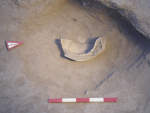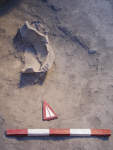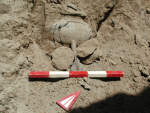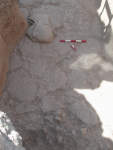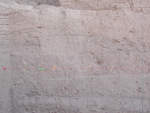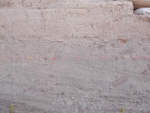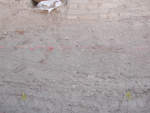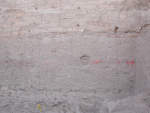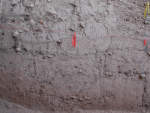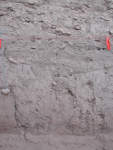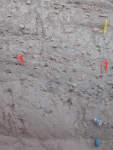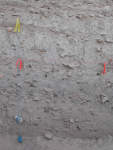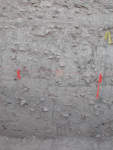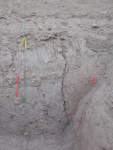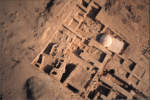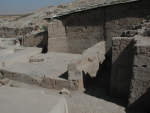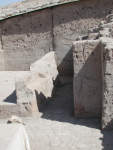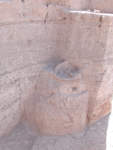1. OVERVIEW
| Roster | Date | Author | Record |
|---|---|---|---|
| Best image | 2014-11-06 | cJC | 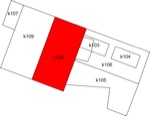 [Input: YY06CJC.j] [Input: YY06CJC.j] |
2. IDENTIFICATION
Designation
| Roster | Date | Author | Record |
|---|---|---|---|
| Description (summary) | 2001-07-31 | fAB | We made this locus when we took down the baulk separating k2 and k6. [Input: -M726-A.j] |
| 2001-07-31 | sV | contains k2, and k6 [Input: L630LR.j] | |
| 2001-08-02 | lr | The baulk separating k2 and k6 was removed on L731 and we have assigned k108 to this whole area. A few features from a2 and a11 have not been removed and these are all located on the Eastern portion of k108. f132, the wall running North-South in former k2, f8 wall running North-South in former k6, and the Southern portion of f9 wall running East-West have not been removed and defines the Eastern perimeter of k108. These walls in k108 make the locus somewhat narrow. [Input: L815LR.j] |
3. STRATIGRAPHY
Recovery/Assignment
| Roster | Date | Author | Record |
|---|---|---|---|
| Daily notes about recovery of elements | 2001-08-01 | lR | In k108 we still have not reached the stone pavement and are deeper than 8500 elevation, which is the elevation of the stone pavement in A13. We decided to pound in a metal shish (nail) to see if there are stones underneath and found that the shish hit something hard. The metal shish was pounded in at the elevation of 8498 and we believe will hit something in the next 25-30 cm. [Input: L816LR.j] |
| 2001-08-02 | lr | In k108 we removed portions of the Western red bricky material to make the Western area straight since we could not identify any clear brick lines to define it as a wall. A ceramic vessel was found in the North portion of k108 in the Western area. The vessel is a black over- fired jar i49 and is in poor state of preservation. [Input: L815LR.j] | |
| 2001-08-02 | lr | In the Western portion of k108, there is red clay protruding approximately 60cm East of the Western baulk. We have interpreted this material as bricks since a few mortar and white plaster lines are visible. This red bricky material is in poor state of preservation making boundary definition difficult. In any case, we have decided to leave this material since it may be the remains of a phase 3 wall, or wall collapse. While excavating the pit fill, which covers the majority of this locus, we encountered the cut of a13. We also found a thin hard clay layer covering the bottom surface of the locus. We removed this hard clay layer and thought we hit stones (of the courtyard) but resulted in discovering baked bricks. The situation is still unclear and we need to uncover the rest of the locus to understand these bricks and there relationship to the courtyard. [Input: L815LR.j] | |
| 2001-08-02 | lr | In the northern portion of k108 we hit stone pavement at elevation 8491, the brick pavement is at 8470 and to the south the stone pavement is at 8503. The stone pavement continues to slope south to north and again down from east to west since k108 is higher than k109. In the south east part of k108, the pot smash has been removed item 48 but some of the pot extends into the baulk and has been left in place. we decided to remove the pot smash that sat on top of the stone pavement since it would most likely have been further damaged and lost if left in place. [Input: L815LR.j] | |
| 2001-08-02 | lr | We have made three new loci to facilitate digging and q-lot assignment. Locus k108 includes k2, and k6; locus k109 includes the Northern portion of k1; and locus k110 includes the Southern portion of k1, k5 and the Northern baulk of k5. [Input: L815LR.j] | |
| 2001-08-22 | lR | On the west side of k108 in the west baulk we have brick-like material running north to south and these two bricks maybe associated with this material. We will not know until this baulk is excavated which we plan to do in controlled layers. [Input: L822LR.j] | |
| 2001-09-02 | lR | For the past few days we have been excavating small portions of k108 primarily the western baulk. Today we began to remove the long pillar of material located in the eastern baulk that was formed in the beginning by a2, which we left a small 150cm x 50cm rectangular hump on the section. This section measures approx three meters and contains gray layers of the pit a13 found throughout the entire area of k108. [Input: L903LR.j] | |
| 2002-09-02 | lR | We started removing the protruding section of k108 on the eastern section. This piece was left when we removed a2 at the top and eventually created a long pillar to the south side. The section measures approx. 150cm x 50cm in width and will be especially useful for pottery analysis since it gives us a sampling from the top of the pit to the bottom (including red material that was cut by the pit). We began to excavate the pillar at the top by removing the interface layer between house accumulation of a2 and pit fill. Since the upper area of the pit is significantly higher than the stone pavement of k108, excavation must be proceeded very slowly with a big pick working down using a ladder. We expect this work to continue for the next few days. [Input: -MX12-99.j] | |
| Argument | 2001-08-02 | lr | We have two possible situations, one that the fired bricks are an earlier phase, a pavement under the palace or that the fired bricks are part of a drainage system since it is in line with the drain found in A13, and may continue underneath the eastern portion of the stone pavement. [Input: L815LR.j] |
| Procedures | 2001-09-02 | lR | we excavated the east baulk pillar by layers. The first feature is the interface between the accumulation from the phase 5b houses from a2 and a11 and the beginning of the pit. The first 30 cm contains a reddish compact layer with the brick foundations seen in the section. This layer serves as a seal between phase 5b and earlier Khabur. The next layer contains soft ashy fill 83 cm in thickness. This material is darker than the rest of the material in the pillar and contians chunks of reddish pink clay, and flakes of charcoal a clear line between this feature and the one below is marked by a thin band of pottery. The next layer was removed which was called an interface layer between the ashy accumulation and the more compact light gray underneath. The remaining material was seperated not by layers since it appears that the matrix is the same, but by 30cm increments to keep the pottery seperate. We are using the pillar as a good documentation of the stratigraphy of the pit and keeping careful seperation between each layer by ensuring that the area is cleaned and all pottery collected before proceeding to the next layer. The pillar was excavated by one person at a time using a ladder and a big pick. The person excavating the pillar was directed by someone below as to when the layer changed. The pillar was then scrapped and all the pottery collected with the khabur sherds seperated. [Input: L903LR.j] |
| Notes on recovery | 2001-08-02 | lr | (continue) After 15 cm down the material became browner and 35 cm down we came down on a hard layer of clay, almost fired which was only 5-6 cm in thickness. this material chunked off with the brown material making it difficult to expose the area in its entirety with this clay. We excavated the area in some cases mixing both the brown and the clay together and underneath we hit something hard which we first interpreted as stone since this was the prediction of the courtyard. After cleaning the area we noticed that the material was not stone but fired bricks f194. The bricks are a pink and yellow color and cover the bottom of the circle with a chunky clay material running north-south in the east. This may be a possible damaged area by the pit cut f189. After excavating the circle in its entirety we noticed large stones forming the same shape as the cut, circular. We then decided to excavate in the southern portion of k108 since we can follow the stones from the pavement in the courtyard to better understand the relationship between the fired bricks and the stone pavement. What we found was that the stones sit on top of the bricks and we have hypothesized that the stones were cut by the pit since the stones from the pavement form a circular shape and the bricks are below. [Input: L815LR.j] |
| 2001-08-02 | lr | In the western portion of k108 we have left the red material which protrudes approximately 60 cm east of the western baulk, which we have interpreted as bricks since a few mortar lines and a few white plaster lines have been identified. This red bricky material is difficult to define due to its poor state of preservation and we have left this material to the west incase it is a phase 3 wall. We have also pedastooled the tannur f180 located in the south east corner of k108 and currently are 260 cm down from the beginning of the pit a13. While excavating inside k108 we noticed a clear line forming a circular pattern that we have defined as the cut of the pit/hallow a13. This cut links all the material in former k2 and k6 below a11, and a2 together since it all belongs to the same pit. This cut is marked very well by a hard compacted reddish brown material that forms no brick shapes just a massive accumulation measuring approximately 50 cm down. The material inside the circle (the fill) peels away easily from the red material and also curves slightly in at the base. The fill inside the circle is gray and brown, softer and full of pottery and bones. We proceeded to excavate the fill first f183. [Input: L815LR.j] | |
| 2001-08-02 | lr | The jar was sitting upright in this bricky red material and was photographed then removed. It was triangulated and removed in pieces since it is so over-fired that it fell apart instantaneously. While removing the vessel small bones were noticed inside which may belong to an infant or a small animal. These remains are labeled as i50. The bones and jar have been defined as a burial and treated as one. [Input: L815LR.j] |
Volumetric Localization
| Roster | Date | Author | Record |
|---|---|---|---|
| Elements within locus | 2001-06-17 | fAB | a12 (pavement) [Input: L724LR.j] |
| 2001-08-18 | lR | a13 (pit) [Input: L724LR.j] | |
| 2001-08-31 | fAB | a17 (pit) [Input: -MX12-99.j] | |
| 2002-09-03 | fAB | a18 (burial) [Input: -MX12-99.j] | |
| 2007-07-16 | cJC | a27 (accumulation) [Input: R716CJC.j] | |
| 2001-06-09 | lr | f187 (accumulation) f188 (layer) f189 (pit) f190 (layer) [Input: L815LR.j] |
|
| 2002-10-02 | lR | f193 (pavement) [Input: -MX12-99.j] | |
| 2001-06-09 | lr | f194 (drain) f195 (fill) [Input: L815LR.j] |
|
| 2007-07-14 | sG | f197 (accumulation) [Input: R714SG.j] | |
| 2001-08-28 | lR | f219 (accumulation) [Input: L901LR.j] | |
| 2001-08-28 | fAB | f221 (accumulation) [Input: L901LR.j] | |
| 2001-08-30 | fAB | f226 (fill) [Input: L901LR.j] | |
| 2007-07-14 | sG | f238 (layer) f239 (fill) f240 (layer) f241 (layer) f242 (fill) f243 (layer) f244 (layer) f245 (layer) [Input: R714SG2.j] |
|
| 2001-06-09 | jLW | f253 (accumulation A) [Input: -MX12-99.j] | |
| 2002-09-05 | MISSING | f258 (accumulation C) f259 (wall) [Input: M928LR.j] |
|
| 2002-09-05 | lR | f270 (accumulation C) [Input: M928LR.j] | |
| 2002-09-22 | fAB | f323 (layer) [Input: M926LR.j] | |
| 2002-09-25 | lR | f330 (fill) [Input: M926LR.j] | |
| 2002-09-25 | fAB | f340 (layer) [Input: M926LR.j] | |
| 2001-07-31 | aBK | i46 (jar) [Input: L818LR3.j] | |
| 2001-07-31 | sV | i47 (human body) [Input: L818LR3.j] | |
| 2001-08-01 | tR | i48 (jar) [Input: L818LR3.j] | |
| 2001-08-02 | sV | i49 (jar) i50 (human body) [Input: L818LR3.j] |
|
| 2002-09-03 | lR | i83 (jar) i84 (human body) [Input: -MX12-99.j] |
|
| 2002-09-25 | aP | i171 (blade) [Input: -MX12-99.j] | |
| 2007-08-13 | sC | i176 (bead) i177 (bead) i178 (bead) i179 (bead) [Input: R812SC.j] |
|
| 2007-08-13 | lr | q723.1 (human body) [Input: R813LR.j] | |
| 2001-08-02 | lR | q413 [Input: -MX12-99.j] | |
| 2001-07-31 | sV | q556 q557 q563 [Input: -MX12-99.j] |
|
| 2001-07-31 | aBK | q566 q567 q568 [Input: -MX12-99.j] |
|
| 2001-07-31 | tR | q582 [Input: N114LR.j] | |
| 2001-08-01 | sV | q586 q587 [Input: -MX12-99.j] |
|
| 2001-08-01 | aBK | q591 q593 q594 [Input: -MX12-99.j] |
|
| 2001-08-01 | tR | q595 [Input: -MX12-99.j] | |
| 2001-08-01 | sV | q598 q599 [Input: -MX12-99.j] |
|
| 2001-08-01 | tR | q600 [Input: -MX12-99.j] | |
| 2001-08-01 | sV | q602 [Input: -MX12-99.j] | |
| 2001-08-01 | tR | q603 q604 q605 q606 [Input: -MX12-99.j] |
|
| 2001-08-02 | sV | q608 [Input: -MX12-99.j] | |
| 2001-08-02 | lR | q612 q613 [Input: L818LR3.j] |
|
| 2001-08-29 | lR | q644 [Input: -MX12-99.j] | |
| 2001-08-29 | fAB | q646 [Input: -MX12-99.j] | |
| 2001-08-30 | fAB | q654 [Input: -MX12-99.j] | |
| 2001-09-02 | lR | q666 q667 q668 q669 q670 q671 q673 [Input: -MX12-99.j] |
|
| 2001-09-03 | lR | q674 q676 q677 [Input: -MX12-99.j] |
|
| 2001-09-04 | lR | q680 [Input: -MX12-99.j] | |
| 2002-09-03 | lR | q687 [Input: MX12LR.j] | |
| 2002-09-05 | lR | q696 q698 [Input: MX12LR.j] |
|
| 2002-09-07 | lR | q711 [Input: MX12LR.j] | |
| 2002-09-08 | lR | q722 q723 q726 [Input: MX12LR.j] |
|
| 2002-09-16 | lR | q816 [Input: MX12LR.j] | |
| 2002-09-21 | lR | q852 [Input: MX12LR.j] | |
| 2002-09-22 | lF | q861 [Input: MX12LR.j] | |
| 2002-09-23 | lF | q872 q875 [Input: MX12LR.j] |
|
| 2002-09-24 | lR | q891 [Input: MX12LR.j] | |
| 2002-09-25 | aP | q896 [Input: MX12LR.j] | |
| Relays (applicable to elements) | 2001-07-31 | sV | rm2598: 200w, 900s [Input: L630LR.j] |
6. REFERENCE
Analogical Record
| Roster | Date | Author | Record |
|---|---|---|---|
| Photo of context (v view) | |||
| View/drawing of locus | |||
